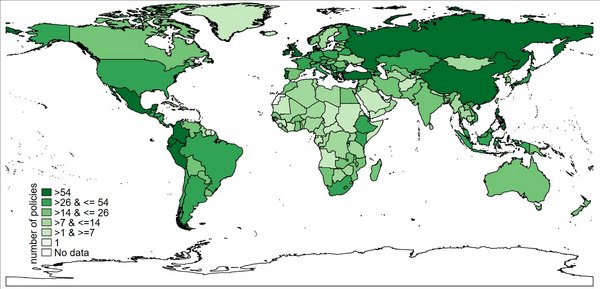 Read this article in French
Read this article in French- Share this article
- Subscribe to our newsletter
All countries’ agri-environmental policies at a glance
Although agriculture is vital for our survival and well-being, it is also responsible for significant greenhouse gas emissions, biodiversity loss and soil degradation. Countries are therefore adopting a huge range of different policies to make agriculture sustainable, from regulations to paying for agri-environmental services. Every year, new laws, programmes, and schemes are introduced all over the world while others are abolished, making it hard to keep track of developments.
This is a problem for researchers and policy decision-makers alike. How are they to go about making comparisons? How can they tell which measures work in which circumstances? Together with colleagues at ETH Zurich, Professor David Wuepper from the Institute for Food and Resource Economics at the University of Bonn has now put together an extensive, easy-to-use database containing 6,124 policies from over 200 countries that were adopted between 1960 and 2022.
The researchers have used two examples to demonstrate how this can be done: how a country’s economic development is linked to its adoption of agri-environmental policies and how such policies impact soil erosion. Their study has now been published in “Nature Food”.
The team’s work focused on measures that meet certain criteria. “First and foremost, the measure has to be relevant to agriculture in some way, such as land use, nitrogen fertilisers or pesticides. Forest conservation is included too, because it’s linked to agriculture in many countries,” explains Wuepper, who is also a member of the PhenoRob Cluster of Excellence at the University of Bonn. The measures have to have national significance, too, meaning that they cannot focus too strongly on the local level, for example. New thematic areas can be added to the database at any time. “We deliberately gave it a modular structure so we can keep on expanding it,” Wuepper notes.
Old question meets new data
Wuepper and his co-authors were quick to use their database to shine new light on an old but contentious question: how does a country’s economic development tie in with its adoption of agri-environmental policies? “You might expect higher-income countries to implement a larger number of eco-friendly measures because the environment is becoming increasingly important in relative terms on the policy front,” Wuepper explains.
Thanks to his database, he has now been able to confirm that this is indeed the case. “We’ve shown that richer countries actually do introduce more measures, generally speaking,” Wuepper says, but adds that here too, it is the exceptions that prove the rule. “This trend doesn’t apply across the board. For instance, the Middle Eastern countries have relatively few agri-environmental policies in place, given their income level. This demonstrates that countries need to make an active effort to implement sustainable policies and that it won’t happen by itself.”
What these policies then actually achieve, however, is another question entirely. “But this is also something that can – and should – be investigated with the help of the database,” Wuepper says, and in fact an initial analysis of this kind is included in the article that has been published.
National policies help fight the problem of soil erosion
The database helped Wuepper answer a question that had been on his mind for some time: in a previous research project at ETH Zürich, he had studied what impact countries have on soil erosion. “Comparing levels of soil erosion along national borders showed that countries exert significant influence,” Wuepper reveals. “At the time, we were able to demonstrate a link to agriculture, and we also thought that national policies might be an influencing factor. However, we couldn’t look into this because we didn’t have the data on the countries’ relevant policies to compare on a global scale.”
Armed with their new policy database, the researchers have now been able to investigate the extent to which this significant influence that countries exert on global erosion can be explained by their policies. They have found that national soil management policies account for at least 43 per cent of a country’s impact on soil erosion.
The database is accessible to the general public at https://zenodo.org/records/10842614
(Bonn University/wi)
Reference:
David Wuepper, Ilsabe Wiebecke, Lara Meier, Sarah Vogelsanger, Selina Bramato, Andrea Fürholz, Robert Finger. “Countries’ Agri-Environmental Policies from 1960 to 2022,” in: “Nature Food,” March 2024; DOI: 10.1038/s43016-024-00945-8.





Add a comment
Be the First to Comment